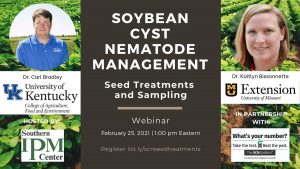Agronomy, Homepage Slider, Soybean Quality
SCN Management: Seed Treatments and Sampling
By Dusty Sonnenberg, CCA, Ohio Field Leader: a project of the Ohio Soybean Council and soybean checkoff.
Soybean Cyst Nematodes are one of the leading yield robbers for Ohio soybean producers every year. “Real damage is being caused by Soybean Cyst Nematodes (SCN),” said Kaitlyn Bissonnette, researcher from the University of Missouri. Ongoing research is being conducted by the SCN Coalition, which is a multi-state public-private partnership between universities and industry partners.

The lifecycle of SCN begins with the adult female cyst nematode in the soil. One female SCN can produce up to 250 eggs per generation. There can be 5-6 generations of SCN per year depending on the location.
There are multiple stages in the SCN life cycle. The adult female nematode produces eggs. Once the eggs are in the soil, the eggs transition from an unhatched juvenile in the egg, to a hatching juvenile, to a penetrating juvenile (penetrating into the soybean root). Once the juvenile has penetrated the root, they develop into an adult and then the females produce more eggs.
It is important to understand the life cycle of SCN because seed treatments can have an impact on three of the juvenile stages. “Seed treatments impact the unhatched juvenile, the hatching juvenile, and penetrating juvenile,” said Dr. Carl Bradley, plant pathologist at the University of Kentucky. “There are several products registered as seed treatments that can affect SCN.”
Avicta® Complete by Syngenta; N-Hibit® Seed Treatment by Direct Enterprise; Votivo® by BASF; Clariva™ pn by Syngenta; ILeVO® Seed Treatment by BASF; Aveo EZ ® Nematacide by Valent; escalate® nemasect by Becks; Trunemco ™ by Nufarm; and Saltro® by Syngenta were all evaluated in a study conducted by the SCN Coalition. Some products such as Clariva™ are targeted specifically for SCN. Several of the other products target all plant-parasitic nematodes. Products such as Votivo ®, Clariva™ pn, Aveo EZ®, Escalate® and Trunemco™ are biological controls. The active ingredients are biological organisms, or products from biologicals. The other seed treatments are chemical controls.
In the SCN seed treatment world, there is a wide range of modes of action, compared to fungicides applied for foliar control of disease or other types of seed treatments. “It is different with nematode control because there are biological controls and chemical controls, in a wide variety of products used,” said Bissonette. “Some products are both fungicides and nematicides. Some of the biologicals do not list a mode of action.”
There is published research reviewing controlled studies conducted both in the lab and greenhouse. “Environment has a huge impact on the seed treatment effect,” said Bissonnette. “There were only two locations where the treatment environments had significant differences. In the first 30 days, the performance of a seed treatment can vary based on the location of the trial.”
“When it comes to SCN reproduction, there was not a significant difference among treatments, but there was a trend,” said Bissonnette. “The environment most likely plays the largest role in reproduction differences. The data showed one location that was close to being significant, but likely the environments itself is much more of a variable, and thus a lot of variation that is occurring is due to the environment.”
“When evaluating seed treatment effectiveness by the yield in the treatment, there does not appear to be an interaction between treatment and environment,” said Bradley. “There were differences in yield among the environments. Different varieties were used and the trials were conducted in different agronomic conditions.” That all needs to be considered as well.
“The non-treated seed was the lowest yielding, and the non-treated was statistically significantly lower than all the treatments, but all the treatments were not significantly different from one another,” said Bradley. “When separated by initial egg count levels, significant differences among treatments were observed at low egg count levels in the low range of (less than 1000 eggs per 100 cc of soil).”

There was a significant difference in yield at 2 of the locations, and one of those had a high SDS environment. “Sometimes the treatments control more than just SCN, it may also help control other diseases,” said Bissonnette. “The largest impact on all factors was the environment. For both the SDS foliar disease index and SDS root rot, there was a significant interaction among the environment and treatment. Treatments differed significantly for yield when all data sets were pooled, but environment was still a significant factor.”
“Environment continues to be the biggest factor driving effectiveness of seed treatments,” said Bissonnette. “SCN initial egg counts may play a role in SCN seed treatment effectiveness, especially for yield impacts. SDS field history likely plays a role in seed treatment effectiveness.”
The researchers noted that most fields have SCN. One reason is that SNC moves on soil peds, on equipment, in water, and with the wind.
Soil Testing is important to know your field and know the numbers,” said Bradley. “Assume a soil test has 200 eggs in a field sample. That is usually 100 females, and 100 males. There can be up to 250 eggs per females. At a 1% egg survival rate for a susceptible SCN soybean variety of seed, after just three generations, there are 39,062 eggs, and there can be 5-6 generations per season.”
When submitting SCN soil tests, farmers are encouraged to fill out submission forms as complete as possible for each submission and field so the lab can provide good info back with a complete report. “Diagnosis is only as good as the soil sample and submission provided,” said Bissonnette. “Properly interpreting SCN soil test results is important. Different states have different numbers, so farmers should check with their local state for the specific range.”
In Ohio, the SCN results are reported per 100 cc of soil. Range groupings are: 0-40, 41-200, 201-2000, 2001-5000, and over 5000.
For the 0-40 range, that is considered virtually none detected, and the management strategy is to continue to monitor the field. For the 41-200 range, that is considered a trace level, and the management strategy is the same. At the 41-200 range, some yield loss in susceptible varieties may occur. At the 201-2000 range, the level is considered low, and growers are recommended to plant resistant SCN varieties or rotate to a non-host crop. At the 2001-5000 range, the level is moderate and farmers should plan to rotate to a non-host crop in the next year and return with a SCN resistant variety the following year. Losses up to 25-50% have been recorded in this range on susceptible varieties. The 5000+ range is rated high, and farmers should rotate to a non-host crop for three years, and then re-sample the field.
Some labs report numbers in 100 CC’s others report in 250 CC’s of soil, so it is important to know the parameters of the report. “The egg count tells the farmer what a SCN baseline is, and dictates the magnitude of the management practice needed,” said Bissonnette.
A SCN management plan starts with a soil test. “Farmers need to and know their SCN levels,” said Bradley. “The next step is to select resistant varieties based on those SCN numbers. Farmers should rotate resistance sources to manage the SCN levels, and also rotate varieties within a resistance source. Best management practices such as crop rotation, using cover crops, and good weed management are also important. Farmers can also consider using a SCN seed treatment.”